load capacity PONTIAC VIBE 2010 Owners Manual
[x] Cancel search | Manufacturer: PONTIAC, Model Year: 2010, Model line: VIBE, Model: PONTIAC VIBE 2010Pages: 318, PDF Size: 1.7 MB
Page 81 of 318

Roof Rack System
Roof Rack
{CAUTION
If something is carried on top of
the vehicle that is longer or wider
than the roof rack — like paneling,
plywood, or a mattress — the wind
can catch it while the vehicle is
being driven. The item being
carried could be violently torn off,
and this could cause a collision,
and damage the vehicle. Never
carry something longer or wider
than the roof rack on top of the
vehicle unless using a GM
Certified accessory carrier.Notice:
Loading cargo on the
roof rack that weighs more than
75 kg (165 lbs) or hangs over
the rear or sides of the vehicle
may damage the vehicle.
Load cargo so that it rests evenly
between the crossrails, making
sure to fasten cargo securely. To prevent damage or loss of cargo
when driving, check to make sure
cross rails and cargo are securely
fastened. Loading cargo on the roof
rack will make the vehicle’s center of
gravity higher. Avoid high speeds,
sudden starts, sharp turns, sudden
braking or abrupt maneuvers,
otherwise it may result in loss of
control. If driving for a long distance,
on rough roads, or at high speeds,
occasionally stop the vehicle to make
sure the cargo remains in its place.
Do not exceed the maximum vehicle
capacity when loading the vehicle.
For more information on vehicle
capacity and loading, see
Vehicle
Load Limits on page 8-12 .
Storage 3-5
Page 146 of 318
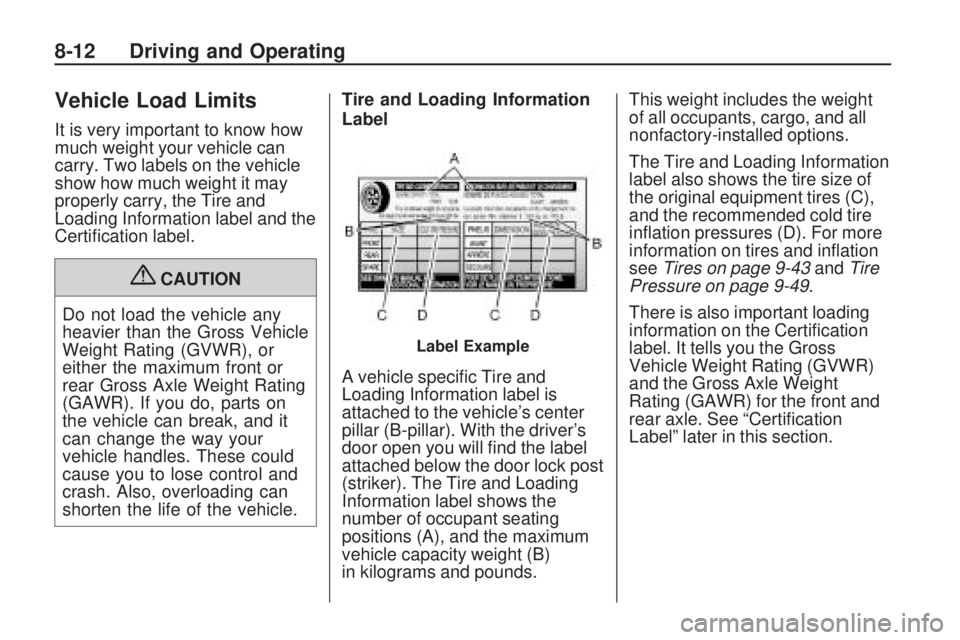
Vehicle Load Limits
It is very important to know how
much weight your vehicle can
carry. Two labels on the vehicle
show how much weight it may
properly carry, the Tire and
Loading Information label and the
Certification label.
{CAUTION
Do not load the vehicle any
heavier than the Gross Vehicle
Weight Rating (GVWR), or
either the maximum front or
rear Gross Axle Weight Rating
(GAWR). If you do, parts on
the vehicle can break, and it
can change the way your
vehicle handles. These could
cause you to lose control and
crash. Also, overloading can
shorten the life of the vehicle. Tire and Loading Information
Label
A vehicle specific Tire and
Loading Information label is
attached to the vehicle’s center
pillar (B-pillar). With the driver’s
door open you will find the label
attached below the door lock post
(striker). The Tire and Loading
Information label shows the
number of occupant seating
positions (A), and the maximum
vehicle capacity weight (B)
in kilograms and pounds. This weight includes the weight
of all occupants, cargo, and all
nonfactory-installed options.
The Tire and Loading Information
label also shows the tire size of
the original equipment tires (C),
and the recommended cold tire
inflation pressures (D). For more
information on tires and inflation
see
Tires on page 9-43 andTire
Pressure on page 9-49.
There is also important loading
information on the Certification
label. It tells you the Gross
Vehicle Weight Rating (GVWR)
and the Gross Axle Weight
Rating (GAWR) for the front and
rear axle. See “Certification
Label” later in this section.
Label Example
8-12 Driving and Operating
Page 147 of 318

Steps for Determining Correct
Load Limit
1.Locate the statement “The
combined weight of occupants
and cargo should never
exceed XXX kg or XXX lbs”
on your vehicle’s placard.
2.Determine the combined
weight of the driver and
passengers that will be riding
in your vehicle.
3.Subtract the combined weight
of the driver and passengers
from XXX kg or XXX lbs.
4.The resulting figure equals the
available amount of cargo and
luggage load capacity. For
example, if the “XXX” amount
equals 1400 lbs and there will
be five 150 lb passengers in
your vehicle, the amount of
available cargo and luggage
load capacity is 650 lbs
(1400 −750 (5 x 150) =
650 lbs).
5.Determine the combined
weight of luggage and cargo
being loaded on the vehicle.
That weight may not safely
exceed the available cargo
and luggage load capacity
calculated in Step 4.
6.If your vehicle will be towing
a trailer, the load from your
trailer will be transferred
to your vehicle. Consult this
manual to determine how
this reduces the available
cargo and luggage load
capacity of your vehicle.
If your vehicle can tow a trailer,
see Trailer Towing on page 8-48
for important information on
towing a trailer, towing safety
rules and trailering tips.
A.Vehicle Capacity Weight
for Example 1 =453 kg
(1,000 lbs).
B.Subtract Occupant Weight
68 kg (150 lbs) ×2 =136 kg
(300 lbs).
C.Available Occupant and
Cargo Weight =317 kg
(700 lbs).
Example 1
Driving and Operating 8-13
Page 148 of 318
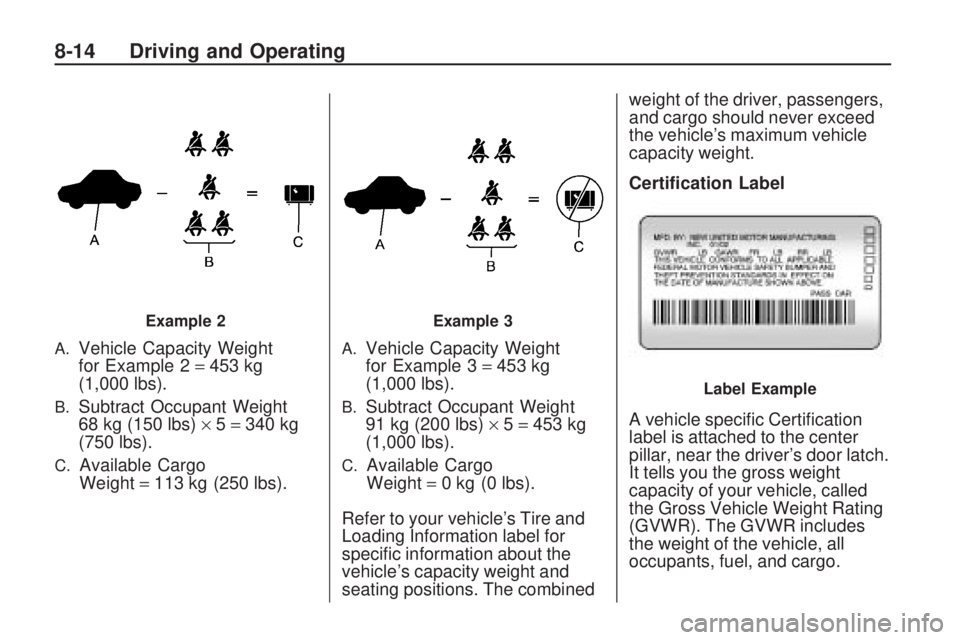
A.Vehicle Capacity Weight
for Example 2 =453 kg
(1,000 lbs).
B.Subtract Occupant Weight
68 kg (150 lbs) ×5 =340 kg
(750 lbs).
C.Available Cargo
Weight =113 kg (250 lbs).
A.Vehicle Capacity Weight
for Example 3 =453 kg
(1,000 lbs).
B.Subtract Occupant Weight
91 kg (200 lbs) ×5 =453 kg
(1,000 lbs).
C.Available Cargo
Weight =0 kg (0 lbs).
Refer to your vehicle’s Tire and
Loading Information label for
specific information about the
vehicle’s capacity weight and
seating positions. The combined weight of the driver, passengers,
and cargo should never exceed
the vehicle’s maximum vehicle
capacity weight.
Certi�cation Label
A vehicle specific Certification
label is attached to the center
pillar, near the driver’s door latch.
It tells you the gross weight
capacity of your vehicle, called
the Gross Vehicle Weight Rating
(GVWR). The GVWR includes
the weight of the vehicle, all
occupants, fuel, and cargo.
Example 2Example 3
Label Example
8-14 Driving and Operating
Page 178 of 318

Driving Characteristics
and Towing Tips
{CAUTION
The driver can lose control when
pulling a trailer if the correct
equipment is not used or the
vehicle is not driven properly.
For example, if the trailer is too
heavy, the brakes may not work
well — or even at all. The driver
and passengers could be seriously
injured. The vehicle may also be
damaged; the resulting repairs
would not be covered by the
vehicle warranty. Pull a trailer only
if all the steps in this section have
been followed. Ask your dealer/
retailer for advice and information
about towing a trailer with the
vehicle.
The vehicle can tow a trailer if it is
equipped with the proper trailer
towing equipment. To identify the
trailering capacity of the vehicle, see Trailer Towing on page 8-48
.
Trailering is different than just driving
the vehicle by itself. Trailering means
changes in handling, acceleration,
braking, durability and fuel economy.
Successful, safe trailering takes
correct equipment, and it has to be
used properly.
The following information has many
time-tested, important trailering tips
and safety rules. Many of these are
important for your safety and that of
your passengers. So please read this
section carefully before pulling a
trailer.
Load-pulling components such as
the engine, transmission, wheel
assemblies and tires are forced to
work harder against the drag of
the added weight. The engine
is required to operate at relatively
higher speeds and under greater
loads, generating extra heat.
Also, the trailer adds considerably
to wind resistance, increasing
the pulling requirements.
Pulling A Trailer
Here are some important points:
•There are many different laws,
including speed limit restrictions,
having to do with trailering. Make
sure the rig will be legal, not only
where you live but also where you
will be driving. A good source for
this information can be state or
provincial police.
•Do not tow a trailer at all during
the first 1 600 km (1,000 miles)
the new vehicle is driven.
The engine, axle or other
parts could be damaged.
•Then, during the first 800 km
(500 miles) that a trailer is towed,
do not drive over 80 km/h
(50 mph) and do not make starts
at full throttle. This helps the
engine and other parts of the
vehicle wear in at the heavier
loads.
8-44 Driving and Operating
Page 182 of 318
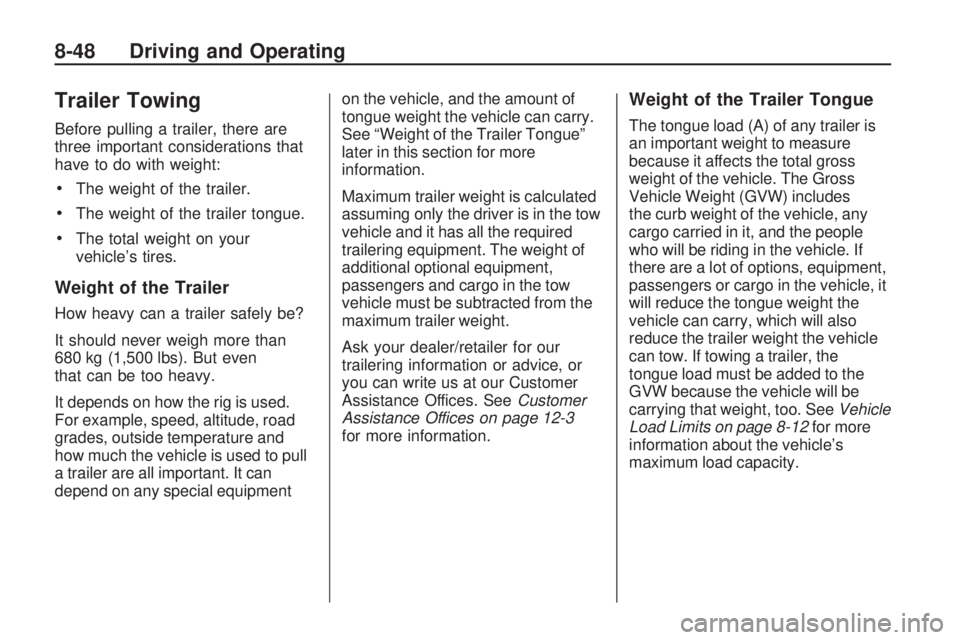
Trailer Towing
Before pulling a trailer, there are
three important considerations that
have to do with weight:
•The weight of the trailer.
•The weight of the trailer tongue.
•The total weight on your
vehicle’s tires.
Weight of the Trailer
How heavy can a trailer safely be?
It should never weigh more than
680 kg (1,500 lbs). But even
that can be too heavy.
It depends on how the rig is used.
For example, speed, altitude, road
grades, outside temperature and
how much the vehicle is used to pull
a trailer are all important. It can
depend on any special equipmenton the vehicle, and the amount of
tongue weight the vehicle can carry.
See “Weight of the Trailer Tongue”
later in this section for more
information.
Maximum trailer weight is calculated
assuming only the driver is in the tow
vehicle and it has all the required
trailering equipment. The weight of
additional optional equipment,
passengers and cargo in the tow
vehicle must be subtracted from the
maximum trailer weight.
Ask your dealer/retailer for our
trailering information or advice, or
you can write us at our Customer
Assistance Offices. See
Customer
Assistance Offices on page 12-3
for more information.
Weight of the Trailer Tongue
The tongue load (A) of any trailer is
an important weight to measure
because it affects the total gross
weight of the vehicle. The Gross
Vehicle Weight (GVW) includes
the curb weight of the vehicle, any
cargo carried in it, and the people
who will be riding in the vehicle. If
there are a lot of options, equipment,
passengers or cargo in the vehicle, it
will reduce the tongue weight the
vehicle can carry, which will also
reduce the trailer weight the vehicle
can tow. If towing a trailer, the
tongue load must be added to the
GVW because the vehicle will be
carrying that weight, too. See Vehicle
Load Limits on page 8-12 for more
information about the vehicle’s
maximum load capacity.
8-48 Driving and Operating
Page 230 of 318
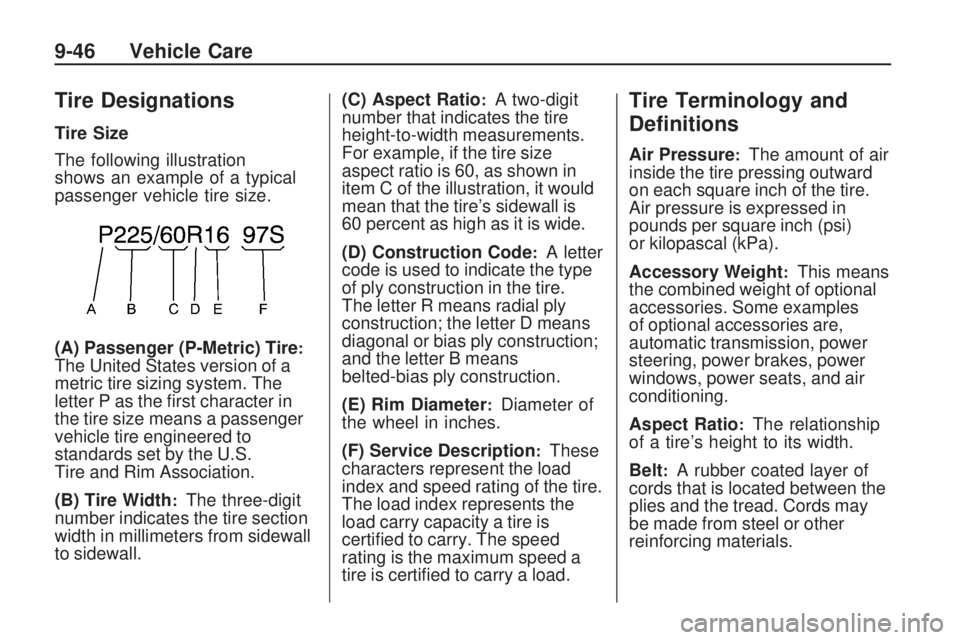
Tire Designations
Tire Size
The following illustration
shows an example of a typical
passenger vehicle tire size.
(A) Passenger (P-Metric) Tire
:The United States version of a
metric tire sizing system. The
letter P as the first character in
the tire size means a passenger
vehicle tire engineered to
standards set by the U.S.
Tire and Rim Association.
(B) Tire Width
:The three-digit
number indicates the tire section
width in millimeters from sidewall
to sidewall. (C) Aspect Ratio
:A two-digit
number that indicates the tire
height-to-width measurements.
For example, if the tire size
aspect ratio is 60, as shown in
item C of the illustration, it would
mean that the tire’s sidewall is
60 percent as high as it is wide.
(D) Construction Code
:A letter
code is used to indicate the type
of ply construction in the tire.
The letter R means radial ply
construction; the letter D means
diagonal or bias ply construction;
and the letter B means
belted-bias ply construction.
(E) Rim Diameter
:Diameter of
the wheel in inches.
(F) Service Description
:These
characters represent the load
index and speed rating of the tire.
The load index represents the
load carry capacity a tire is
certified to carry. The speed
rating is the maximum speed a
tire is certified to carry a load.
Tire Terminology and
De�nitions
Air Pressure:The amount of air
inside the tire pressing outward
on each square inch of the tire.
Air pressure is expressed in
pounds per square inch (psi)
or kilopascal (kPa).
Accessory Weight
:This means
the combined weight of optional
accessories. Some examples
of optional accessories are,
automatic transmission, power
steering, power brakes, power
windows, power seats, and air
conditioning.
Aspect Ratio
:The relationship
of a tire’s height to its width.
Belt
:A rubber coated layer of
cords that is located between the
plies and the tread. Cords may
be made from steel or other
reinforcing materials.
9-46 Vehicle Care
Page 231 of 318
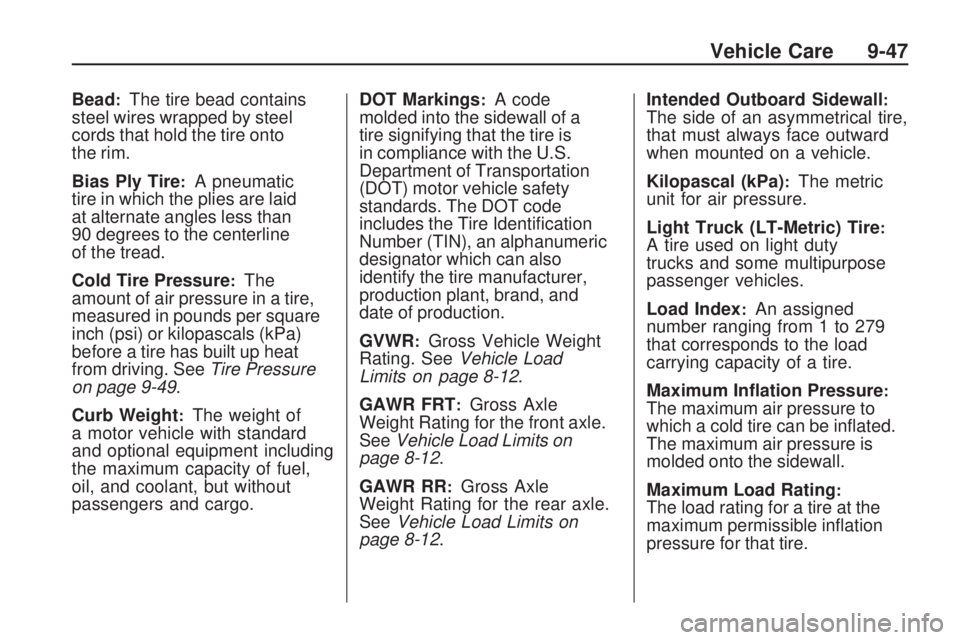
Bead:The tire bead contains
steel wires wrapped by steel
cords that hold the tire onto
the rim.
Bias Ply Tire
:A pneumatic
tire in which the plies are laid
at alternate angles less than
90 degrees to the centerline
of the tread.
Cold Tire Pressure
:The
amount of air pressure in a tire,
measured in pounds per square
inch (psi) or kilopascals (kPa)
before a tire has built up heat
from driving. See Tire Pressure
on page 9-49.
Curb Weight
:The weight of
a motor vehicle with standard
and optional equipment including
the maximum capacity of fuel,
oil, and coolant, but without
passengers and cargo. DOT Markings
:A code
molded into the sidewall of a
tire signifying that the tire is
in compliance with the U.S.
Department of Transportation
(DOT) motor vehicle safety
standards. The DOT code
includes the Tire Identification
Number (TIN), an alphanumeric
designator which can also
identify the tire manufacturer,
production plant, brand, and
date of production.
GVWR
:Gross Vehicle Weight
Rating. See Vehicle Load
Limits on page 8-12.
GAWR FRT
:Gross Axle
Weight Rating for the front axle.
See Vehicle Load Limits on
page 8-12.
GAWR RR
:Gross Axle
Weight Rating for the rear axle.
See Vehicle Load Limits on
page 8-12. Intended Outboard Sidewall
:The side of an asymmetrical tire,
that must always face outward
when mounted on a vehicle.
Kilopascal (kPa)
:The metric
unit for air pressure.
Light Truck (LT-Metric) Tire
:A tire used on light duty
trucks and some multipurpose
passenger vehicles.
Load Index
:An assigned
number ranging from 1 to 279
that corresponds to the load
carrying capacity of a tire.
Maximum In�ation Pressure
:The maximum air pressure to
which a cold tire can be inflated.
The maximum air pressure is
molded onto the sidewall.
Maximum Load Rating
:The load rating for a tire at the
maximum permissible inflation
pressure for that tire.
Vehicle Care 9-47
Page 232 of 318
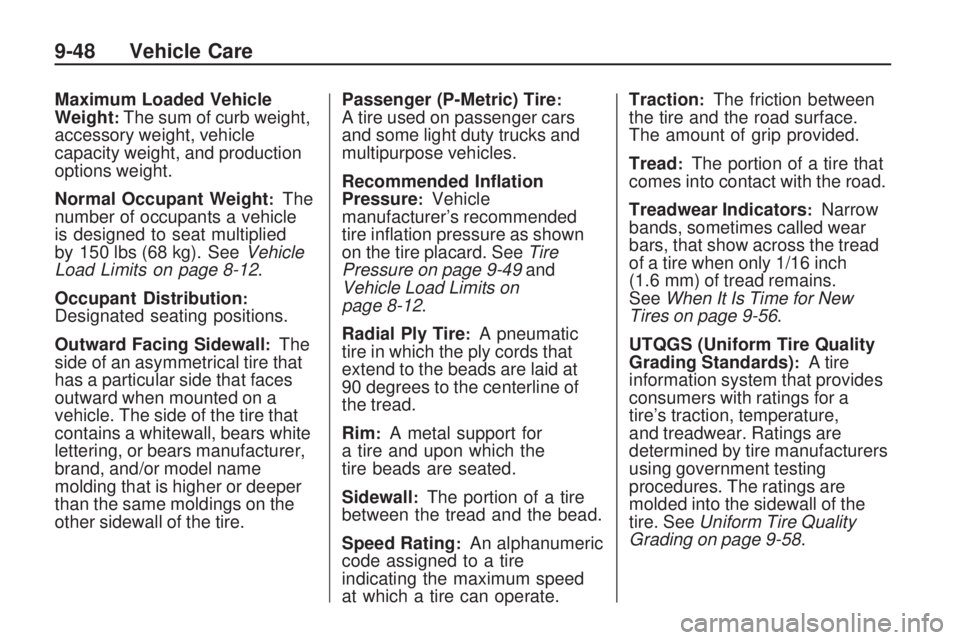
Maximum Loaded Vehicle
Weight:The sum of curb weight,
accessory weight, vehicle
capacity weight, and production
options weight.
Normal Occupant Weight
:The
number of occupants a vehicle
is designed to seat multiplied
by 150 lbs (68 kg). See Vehicle
Load Limits on page 8-12.
Occupant Distribution
:Designated seating positions.
Outward Facing Sidewall
:The
side of an asymmetrical tire that
has a particular side that faces
outward when mounted on a
vehicle. The side of the tire that
contains a whitewall, bears white
lettering, or bears manufacturer,
brand, and/or model name
molding that is higher or deeper
than the same moldings on the
other sidewall of the tire. Passenger (P-Metric) Tire
:A tire used on passenger cars
and some light duty trucks and
multipurpose vehicles.
Recommended In�ation
Pressure
:Vehicle
manufacturer’s recommended
tire inflation pressure as shown
on the tire placard. See Tire
Pressure on page 9-49 and
Vehicle Load Limits on
page 8-12.
Radial Ply Tire
:A pneumatic
tire in which the ply cords that
extend to the beads are laid at
90 degrees to the centerline of
the tread.
Rim
:A metal support for
a tire and upon which the
tire beads are seated.
Sidewall
:The portion of a tire
between the tread and the bead.
Speed Rating
:An alphanumeric
code assigned to a tire
indicating the maximum speed
at which a tire can operate. Traction
:The friction between
the tire and the road surface.
The amount of grip provided.
Tread
:The portion of a tire that
comes into contact with the road.
Treadwear Indicators
:Narrow
bands, sometimes called wear
bars, that show across the tread
of a tire when only 1/16 inch
(1.6 mm) of tread remains.
See When It Is Time for New
Tires on page 9-56.
UTQGS (Uniform Tire Quality
Grading Standards)
:A tire
information system that provides
consumers with ratings for a
tire’s traction, temperature,
and treadwear. Ratings are
determined by tire manufacturers
using government testing
procedures. The ratings are
molded into the sidewall of the
tire. See Uniform Tire Quality
Grading on page 9-58.
9-48 Vehicle Care
Page 233 of 318
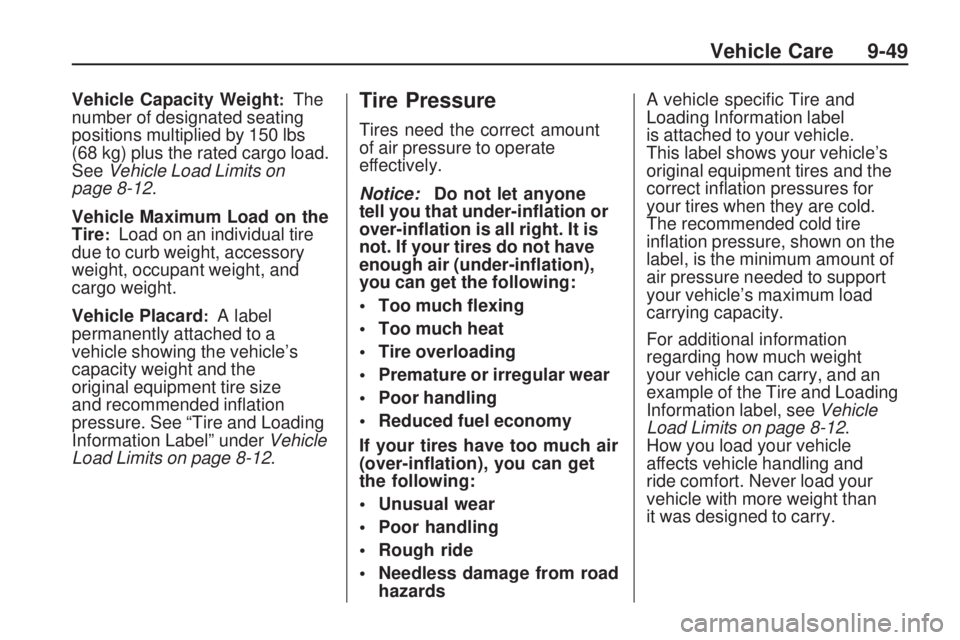
Vehicle Capacity Weight:The
number of designated seating
positions multiplied by 150 lbs
(68 kg) plus the rated cargo load.
See Vehicle Load Limits on
page 8-12.
Vehicle Maximum Load on the
Tire
:Load on an individual tire
due to curb weight, accessory
weight, occupant weight, and
cargo weight.
Vehicle Placard
:A label
permanently attached to a
vehicle showing the vehicle’s
capacity weight and the
original equipment tire size
and recommended inflation
pressure. See “Tire and Loading
Information Label” under Vehicle
Load Limits on page 8-12 .
Tire Pressure
Tires need the correct amount
of air pressure to operate
effectively.
Notice:Do not let anyone
tell you that under-in�ation or
over-in�ation is all right. It is
not. If your tires do not have
enough air (under-in�ation),
you can get the following:
Too much �exing
Too much heat
Tire overloading
Premature or irregular wear
Poor handling
Reduced fuel economy
If your tires have too much air
(over-in�ation), you can get
the following:
Unusual wear
Poor handling
Rough ride
Needless damage from road hazards A vehicle specific Tire and
Loading Information label
is attached to your vehicle.
This label shows your vehicle’s
original equipment tires and the
correct inflation pressures for
your tires when they are cold.
The recommended cold tire
inflation pressure, shown on the
label, is the minimum amount of
air pressure needed to support
your vehicle’s maximum load
carrying capacity.
For additional information
regarding how much weight
your vehicle can carry, and an
example of the Tire and Loading
Information label, see
Vehicle
Load Limits on page 8-12 .
How you load your vehicle
affects vehicle handling and
ride comfort. Never load your
vehicle with more weight than
it was designed to carry.
Vehicle Care 9-49